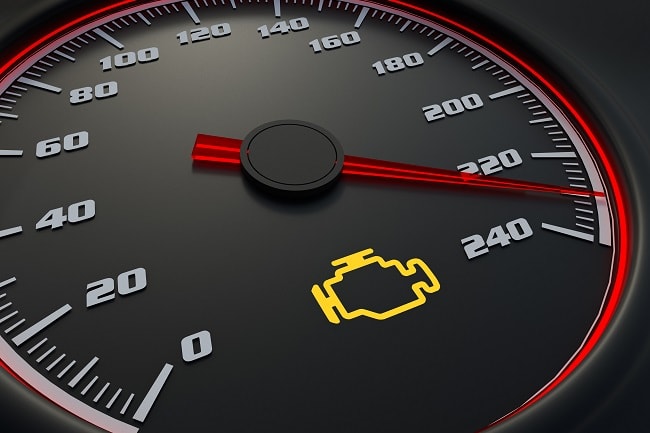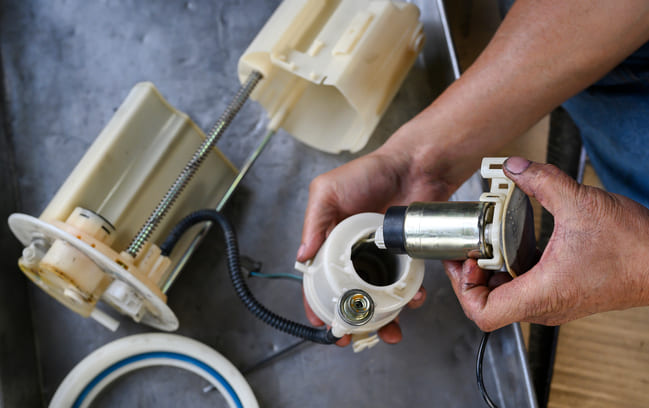
The fuel pump is, as its name suggests, responsible for bringing fuel in the required quantity and pressure from the tank to the engine, more precisely, to the fuel injectors inside the cylinders. To do this, it provides a constant pressure, depending on the model, between 3 and 10 bars. While diesel engines have always been equipped with fuel pumps, their use in gasoline vehicles only concerns models after 1993, the year in which they began to become widespread to the detriment of the carburetor. Furthermore, while older models still operated on a mechanical principle and were driven by the camshaft, more modern ones are electric.
Differences in the operation of mechanical pumps and electric pumps
A mechanical fuel pump is driven by the camshaft or by a special shaft driven by the crankshaft. As the shaft rotates, a cam passes under a pivoting lever and pushes it up at one end. The other end of the lever, which is loosely connected to a rubber diaphragm forming the bottom of one of the pump chambers, moves down and pulls the diaphragm with it. As the lever pulls the diaphragm down, it creates a suction that draws fuel along the fuel line into the pump through a one-way valve. As the rotating cam rotates, so that it no longer puts pressure on the lever, the lever is returned by a return spring, releasing its pressure on the diaphragm. The loose lever does not push the diaphragm up, but a return spring puts pressure on it. The diaphragm can only move up by forcing gasoline out of the chamber. Fuel cannot return through the first one-way valve, so it exits through another valve that leads to the carburetor. The carburetor only admits fuel when it needs it.
An electric pump has a similar arrangement of diaphragm and valve, but instead of the camshaft, a solenoid (an electromagnetic switch) pulls on the diaphragm. The solenoid attracts an iron rod that pulls the diaphragm down, drawing gasoline into the chamber. At the end of its stroke, the iron rod pushes apart a set of contacts, cutting off the current to the electromagnet and releasing the pull on the diaphragm. When the diaphragm's return spring lifts the diaphragm, it also pulls the rod away from the contacts; the contacts then close so that the electromagnet pulls the rod and diaphragm down again.
What can damage a fuel pump?
The fuel pump is an essential part of the vehicle's operation. Unlike other parts of your car, it is not subject to wear and tear; it is therefore designed to last the entire service life of the vehicle. However, certain external factors can sometimes damage it. These include fuel filters that are clogged or obstructed by impurities, as well as faulty electrical connections. Mechanically actuated pumps can be affected by a fault in the transmission of the camshaft movement. A faulty fuel pump is detrimental to the entire operation of the engine. So, do not wait to replace it or have it replaced.
What are the symptoms of a failing fuel pump?
To know if your fuel pump is affected by a failure, pay attention to the following symptoms:
Engine light is on.
- Difficulty starting; cannot start.
- Engine power loss.
- Unusual noise coming from the vehicle's fuel tank.
- Misfires when driving the vehicle; jerky operation.
How to check if the fuel pump is faulty?
How to fix a bad fuel pump?
- Check that the fuel filter is not clogged or obstructed. As a general rule, it should be changed every 60,000 kilometers or every four years.
- Check that the fuel lines and pipes are not damaged or clogged. If so, unclog or replace them.
- Check that the wiring leading to the fuel pump is intact and does not have any defects such as tears, corrosion, or short circuits. Replace all damaged wires and connectors.
How do you replace a faulty fuel pump?
- Access the engine compartment and disconnect the battery.
- Remove the rear seat bench.
- Access the tank and remove the cover.
- Disconnect the fuel level gauge connector.
- Remove the faulty fuel pump.
- Make sure the new pump is identical to the old one.
- Ensure the fuel level sensor is functional; replace it if necessary.
- Replace the fuel filter.
- Install the fuel pump in the location provided for this purpose.
- Replace the tank cover.
- Replace the rear seat bench.
- Reconnect the battery.





Post a Comment